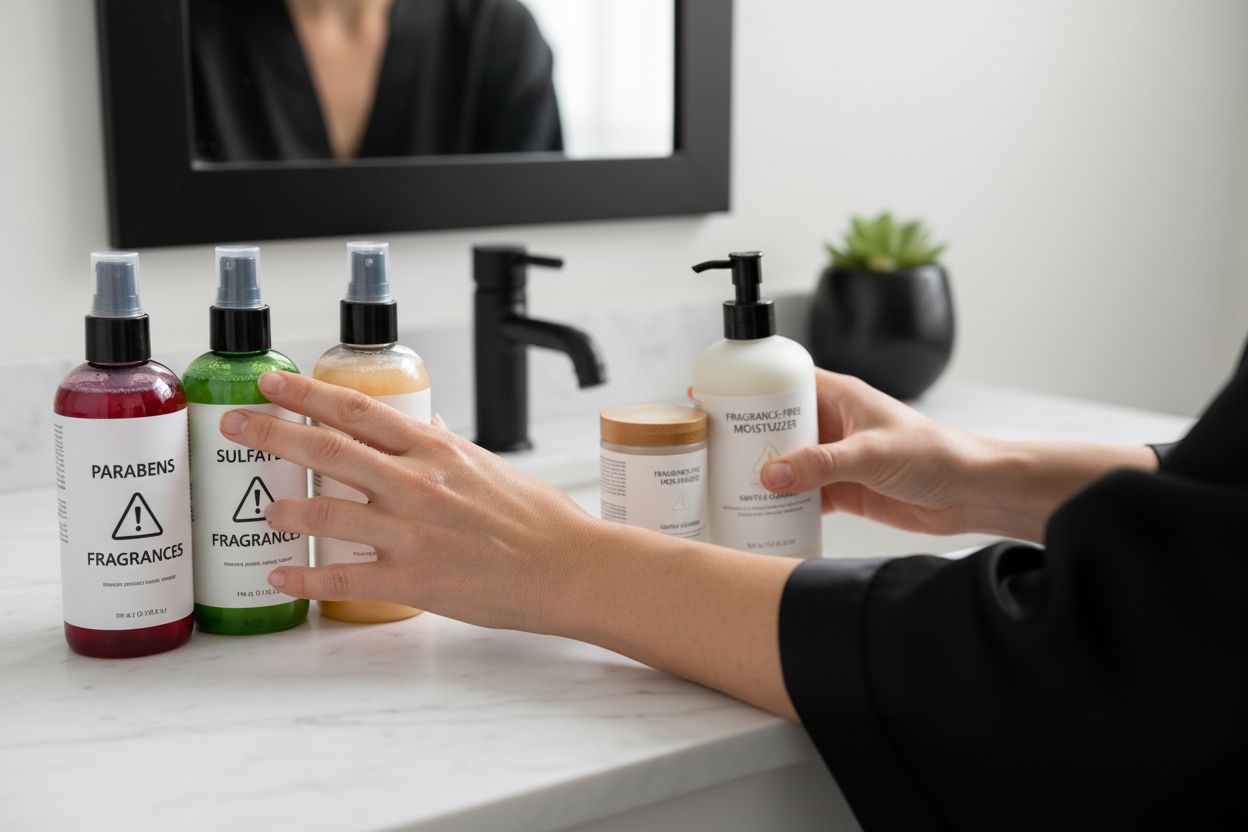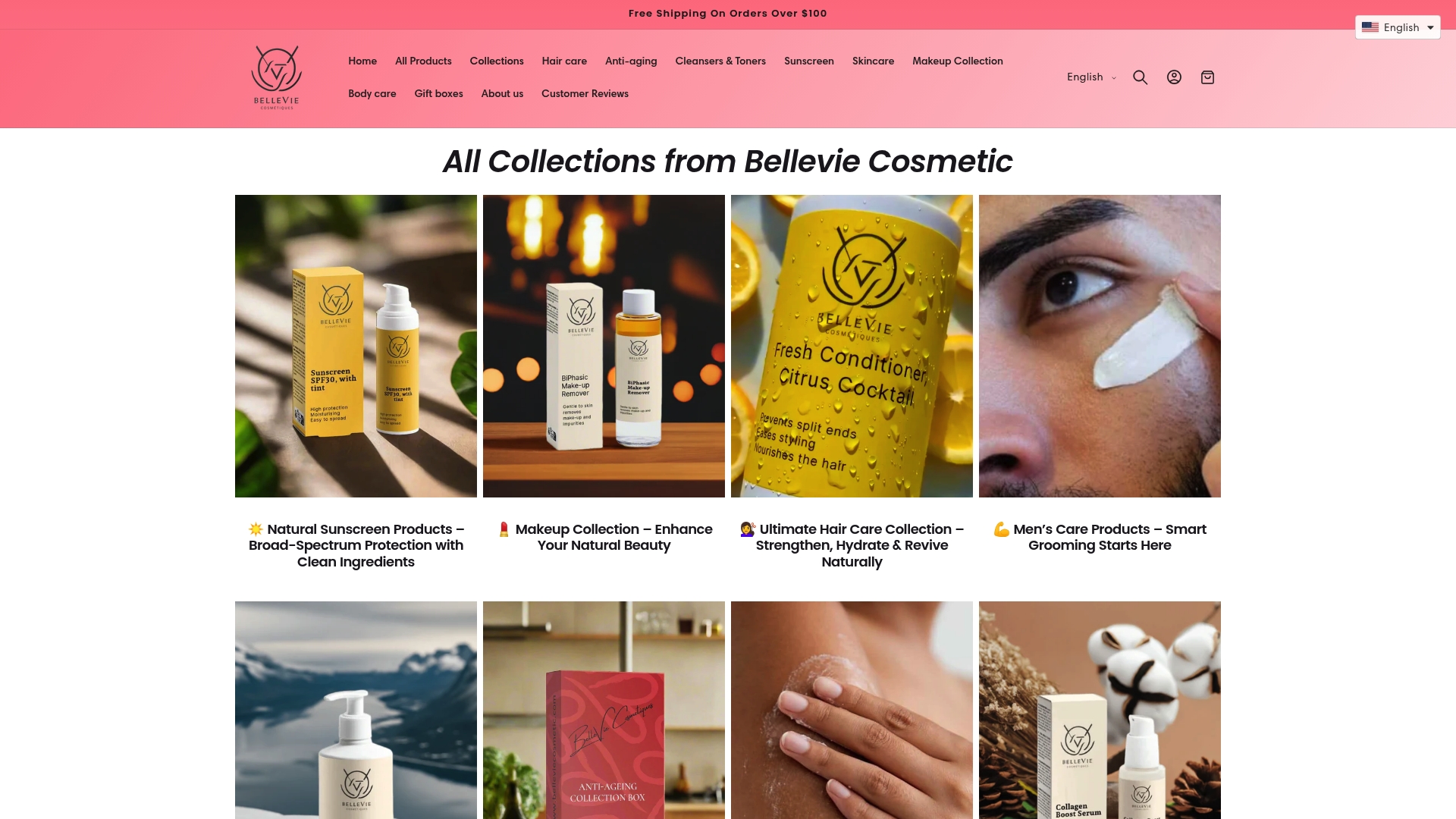Up to 60 percent of adults with sensitive skin report reactions to common skincare products, yet many triggers remain hidden in plain sight. If your face is suddenly red, itchy, or uncomfortable, the real culprit could be a single overlooked ingredient. Understanding how to spot and remove these sneaky irritants will help you regain control and keep your complexion calm. Expect practical steps that bring lasting comfort and confidence to your daily routine.
Quick Summary
| Key Point | Explanation |
|---|---|
| 1. Identify potential allergens | Systematically list skincare ingredients to spot known irritants. |
| 2. Eliminate harsh ingredients | Remove products containing sulfates, alcohol, fragrances, and parabens. |
| 3. Conduct patch tests for safety | Test new products on a small skin area to catch allergic reactions early. |
| 4. Use natural remedies for relief | Utilize oatmeal, baking soda, and olive oil to soothe allergic reactions. |
| 5. Monitor skin changes actively | Keep a skin journal to track improvements and signal when to consult a dermatologist. |
Table of Contents
- Step 1: Identify Allergy Triggers In Your Skincare Routine
- Step 2: Eliminate Potential Irritants From Your Products
- Step 3: Patch Test New Products For Safe Application
- Step 4: Soothe Allergic Reactions With Gentle Natural Remedies
- Step 5: Monitor Skin For Improvements After Changes
Step 1: Identify allergy triggers in your skincare routine
Discovering what’s causing your skin to react requires detective work and patience. This guide will help you systematically uncover potential allergens lurking in your skincare products.
Start by becoming a product label investigator. According to research from WebMD, common skincare allergens include preservatives like parabens, formaldehyde-releasing chemicals, phenoxyethanol, and synthetic fragrances. Your mission is to create a comprehensive ingredient inventory of everything currently in your skincare arsenal.
Grab a notebook and list every product you use regularly. For each item, carefully examine the ingredient list. Look specifically for known irritants such as methylchloroisothiazolinone, methylisothiazolinone, and alpha-hydroxy acids above 10% concentration. As dermatologists recommend, minimalist formulas with fewer ingredients reduce your exposure to potential triggers.
Pro Tip: When checking ingredients, watch for hidden allergens in fragrance components like linalool and limonene.
To pinpoint exact culprits, consider performing a patch test. Apply a small amount of each product on your inner forearm and monitor for reactions over 24-48 hours. Any redness, itching, or swelling signals a potential allergy. Learn more about treating skin allergies naturally for comprehensive guidance.
Remember that individual sensitivity varies. What triggers a reaction for one person might be perfectly safe for another. Patience and systematic elimination will be your greatest allies in uncovering your skin’s unique sensitivities.
Step 2: Eliminate potential irritants from your productsCleaning up your skincare routine means strategically removing ingredients that could trigger sensitive skin reactions. Your goal is creating a gentle product lineup that supports healthy skin without causing unnecessary inflammation.According to dermatology experts, certain ingredients are notorious for causing skin irritation. Sulfates, alcohol, retinol, fragrances, and parabens top the list of potential troublemakers. As research from DS Dermatology indicates, building a sensitive skin routine requires carefully curating your product selection.Start by scanning your current products and ruthlessly eliminate anything containing these harsh ingredients. Replace them with skin-friendly alternatives that support hydration and protection. Look for products featuring gentle ingredients like glycerin, dimethicone, shea butter, and sodium hyaluronate. These components provide moisture without triggering inflammatory responses.> Pro Tip: Choose fragrance-free products across all categories including soaps, moisturizers, and even laundry detergents to minimize potential irritants. Learn more about toxic ingredients in cosmetics and protect your skin.When shopping for new products, prioritize minimalist formulations with fewer ingredients. This approach reduces your exposure to potential allergens and simplifies your skincare routine. Remember that clean beauty isnt just a trend its a strategic approach to maintaining healthy skin.

Here’s a quick comparison of common skincare allergens and their safer alternatives:
![]()
| Allergen/Irritant | Common Sources | Safer Alternative Ingredients |
|---|---|---|
| Parabens | Preservatives in creams, lotions | Potassium sorbate Sodium benzoate |
| Synthetic Fragrance | Perfumes, scented products | Fragrance-free Essential oil-free |
| Sulfates | Foaming cleansers, shampoos | Gentle surfactants Coco-glucoside |
| Alcohol (denat.) | Toners, gels | Glycerin Propylene glycol |
| Retinol | Anti-aging serums, creams | Bakuchiol Peptides |
| Alpha Hydroxy Acids >10% | Peels, exfoliators, toners | Lactic acid (low %) PHA |
| Formaldehyde-releasers | Some moisturizers, hair treatments | Preservative-free Natural extracts |
Step 3: Patch test new products for safe application
Before slathering a new product all over your face, you need a strategic approach to ensure your skin stays calm and irritation-free. A patch test is your secret weapon in preventing potential allergic reactions and protecting your skin’s delicate balance.
According to dermatology research, patch testing is the gold standard for identifying potential skincare allergens. The process is simple but requires patience. Select a small area of skin typically the inner forearm or behind your ear where the skin is less sensitive. Clean the area thoroughly and apply a pea-sized amount of the new product.
Leave the product on for 24 to 48 hours without washing the area. Watch carefully for any signs of reaction such as redness, itching, burning, or swelling. As Allure reports, professional patch tests can involve 40 to 90 different allergens applied under controlled conditions, but your at-home version follows the same core principle observation.
Pro Tip: Always test new products one at a time so you can clearly identify which specific item triggers a reaction.
Understand more about skin sensitivity and product selection to make informed skincare choices. If you experience any negative reactions during your patch test, immediately remove the product and wash the area with cool water.
Consider consulting a dermatologist for persistent skin concerns or complex allergic responses.
Step 4: Soothe allergic reactions with gentle natural remedies
When your skin erupts in an allergic reaction, you need fast and natural relief strategies that calm inflammation without causing additional irritation. Understanding how to effectively soothe your skin can transform a painful reaction into a manageable healing process.
According to Healthline research, some of the most powerful natural remedies come straight from your kitchen. Oatmeal emerges as a surprising hero with its potent antioxidant and anti inflammatory properties. Create a soothing oatmeal bath by grinding plain oatmeal into a fine powder and mixing it with lukewarm bathwater. Alternatively, make a healing poultice by mixing the powdered oatmeal with a small amount of water to create a gentle paste.
Baking soda offers another remarkable solution. Its ability to restore skin pH balance makes it an excellent remedy for allergic reactions. Mix a small amount with water to create a calming paste that can be applied directly to irritated areas. According to natural health sources, extra virgin olive oil rich in vitamin E can also provide moisture and relief to inflamed skin.
Pro Tip: Always use cool or lukewarm water when treating allergic skin reactions to prevent further irritation.
Learn more about natural skin healing techniques and discover additional strategies for managing sensitive skin. Herbal remedies like aloe vera, chamomile, and calendula can provide additional soothing benefits. If symptoms persist or worsen, consult a healthcare professional to rule out more serious allergic responses.
Step 5: Monitor skin for improvements after changesManaging skincare allergies is a journey of patience and careful observation. Your skin will communicate its healing progress through subtle and sometimes not so subtle signals that require your consistent attention and understanding.Start by creating a detailed skin journal to track your progress systematically. Take clear photographs of your skin under consistent lighting every week. Note specific changes like redness reduction, texture improvement, decreased inflammation, and overall comfort level. Pay attention to how your skin feels not just looks track sensations like itching, burning, or sensitivity.The first two weeks are crucial for understanding how your skin responds to the new allergen elimination strategy. Look for progressive improvements such as reduced breakouts, more even skin tone, and decreased reactive episodes. Some changes might be gradual so dont get discouraged if transformations are not immediate.> Pro Tip: Take photos at the same time of day with similar lighting to ensure accurate comparison.Discover how to reset your entire skincare routine for comprehensive skin health management. If you notice persistent issues or no improvement after four weeks consider consulting a dermatologist who can provide personalized insights into your specific skin concerns. Remember healing is not linear skin recovery takes time and consistent gentle care.
Take Control of Skincare Allergies with Clean European Formulas
Are you tired of reacting to hidden irritants in your daily routine? The steps you just learned about identifying triggers and eliminating harsh chemicals are easier when you have access to gentle, science-backed products. At Belle Vie Cosmetic, we specialize in natural, organic skincare that supports sensitive skin and reduces the risk of allergic flareups. Explore our natural skincare collection for products that exclude common irritants like synthetic fragrance, parabens and sulfates.

Ready to craft a routine that puts your skin health first? Visit Belle Vie Cosmetic and discover our full range of clean beauty essentials, including natural facial cleansers and toners designed with sensitive skin in mind. Start your allergy-safe beauty ritual today and transform the way your skin looks and feels. Shop now for the confidence of clear, comfortable skin.
Frequently Asked Questions
How can I identify allergens in my skincare routine?
To identify allergens in your skincare routine, start by investigating product labels. Create a list of all ingredients in your products and look for common irritants like parabens and synthetic fragrances.
What should I do if I find an irritating ingredient in my skincare products?
If you find an irritating ingredient, eliminate that product from your routine immediately. Replace it with gentle alternatives that are free from known allergens and feature skin-friendly ingredients.
How can I accurately patch test new skincare products?
To patch test new products, apply a small amount to a discreet area, such as your inner forearm, and leave it for 24 to 48 hours. Monitor for any redness or irritation during this time to ensure the product is safe for your skin.
What natural remedies can soothe allergic skin reactions?
Natural remedies like oatmeal, baking soda, and extra virgin olive oil can soothe allergic reactions. Create a calming paste with baking soda and water, or mix ground oatmeal with water to make a healing poultice for irritated skin.
How long should I monitor my skin after making changes to my routine?
Monitor your skin for at least four weeks after making changes to your skincare routine. Keep a detailed skin journal and note any improvements in texture and comfort to understand your skin’s healing progress.
What steps should I take if my skin does not improve?
If your skin does not improve after four weeks, consider consulting a dermatologist for personalized insights. Document your skin’s reactions and any products used to provide valuable information during your consultation.
